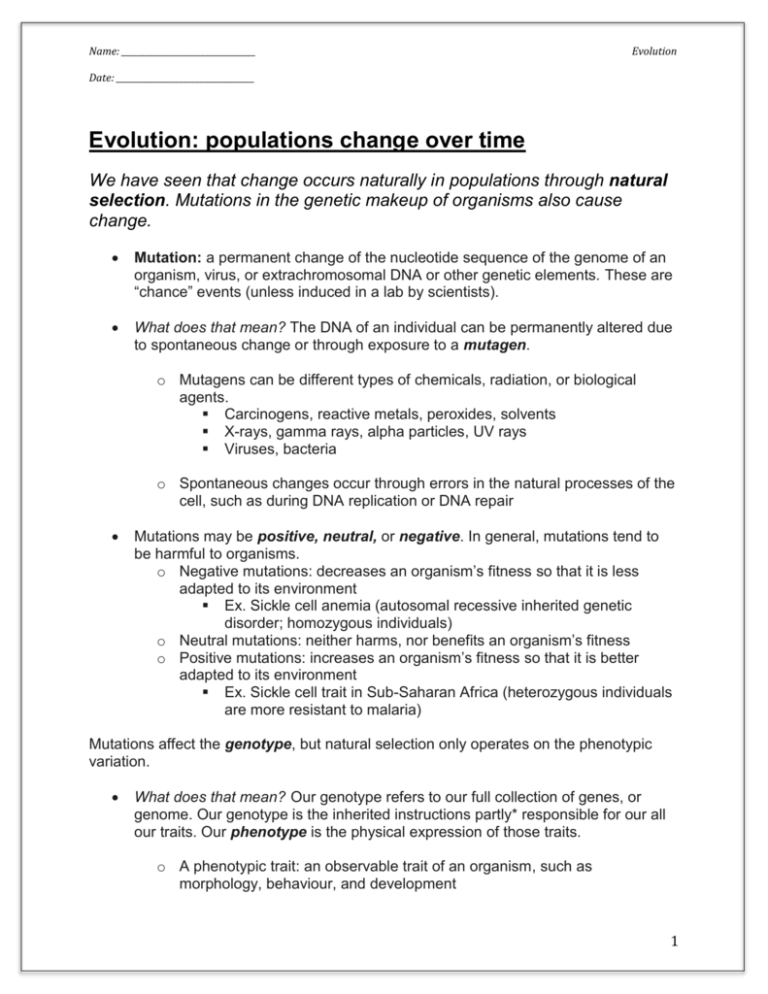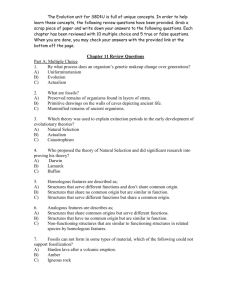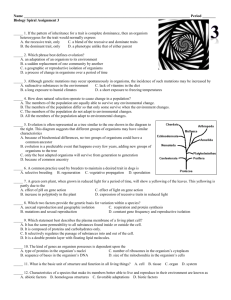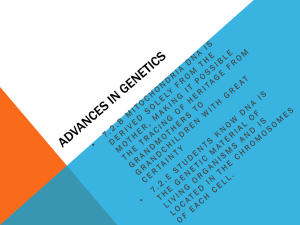File - Ms. Ellis` Classroom
advertisement

Name: ________________________________ Evolution Date: _________________________________ Evolution: populations change over time We have seen that change occurs naturally in populations through natural selection. Mutations in the genetic makeup of organisms also cause change. Mutation: a permanent change of the nucleotide sequence of the genome of an organism, virus, or extrachromosomal DNA or other genetic elements. These are “chance” events (unless induced in a lab by scientists). What does that mean? The DNA of an individual can be permanently altered due to spontaneous change or through exposure to a mutagen. o Mutagens can be different types of chemicals, radiation, or biological agents. Carcinogens, reactive metals, peroxides, solvents X-rays, gamma rays, alpha particles, UV rays Viruses, bacteria o Spontaneous changes occur through errors in the natural processes of the cell, such as during DNA replication or DNA repair Mutations may be positive, neutral, or negative. In general, mutations tend to be harmful to organisms. o Negative mutations: decreases an organism’s fitness so that it is less adapted to its environment Ex. Sickle cell anemia (autosomal recessive inherited genetic disorder; homozygous individuals) o Neutral mutations: neither harms, nor benefits an organism’s fitness o Positive mutations: increases an organism’s fitness so that it is better adapted to its environment Ex. Sickle cell trait in Sub-Saharan Africa (heterozygous individuals are more resistant to malaria) Mutations affect the genotype, but natural selection only operates on the phenotypic variation. What does that mean? Our genotype refers to our full collection of genes, or genome. Our genotype is the inherited instructions partly* responsible for our all our traits. Our phenotype is the physical expression of those traits. o A phenotypic trait: an observable trait of an organism, such as morphology, behaviour, and development 1 Name: ________________________________ Evolution Date: _________________________________ Ex. Blue eyes o Genotype: the set of genes that carry the instructions that ultimately lead to that trait Ex. The genes that code for blue eyes * Environmental, behavior, and other factors also influence the phenotype of an organism. It is the physical and behavioural characteristics that determine an organism’s chances of survival and reproductive output The inheritance of physical properties occurs only as a secondary consequence of the inheritance of genes Theory of Evolution Recall Darwin’s theory: that all organisms evolved from shared or common ancestors Darwin did not really provide evidence on how new species actually arose; this came later with Gregor Mendel (1822—1844) and the discovery of Mendelian genetics. Recall that a theory attempts to explain something with many ideas. The modern “Theory of Evolution” is an amalgamation of different scientific ideas, laws, and hypotheses. In simple terms, the modern evolutionary synthesis combines Darwin’s original ideas with our modern understanding of genetics. That is to say, in very simplified terms, evolution occurs gradually when small genetic changes, regulated by natural selection, accumulate over long periods of time. https://www.youtube.com/watch?v=GhHOjC4oxh8 “What is Evolution?” Stated Clearly Evidence for the Theory of Evolution Comparative Anatomy: o Different organisms have similar clumps of cells that develop into limbs that look quite similar—homologous structures 2 Name: ________________________________ Evolution Date: _________________________________ o As embryos mature, these grow into structures with different functions— arms, wings, legs, flippers etc. Embryology and Development: o Embryos of many different animals look so similar so this is thought to indicate a shared heritage Why would the early stages of development remain so similar? Mutations that would affect early development would likely be lethal. DNA Comparisons: o DNA, RNA, proteins appear similar in structure and role in all organisms o Those with genomes that appear most similar are said to be more closely related—ie. to have evolved from a common ancestor more recently Cytology: o Similarity exists between the structure and function of cells of different Most organisms have mitochondria, chromosomes, Golgi bodies, etc. o All cells use ATP as an energy source o Similarity exists in chromosome structure, mitosis, etc. Fossil Record and Geology: o Fossils show organisms that appear similar to modern day organisms, but with distinct differences o Sedimentary rock traps fossils of organisms in layers. As time passes, layers build up and provide a rough timeline for the fossils—ie. the deeper organisms are older. Carbon dating and the age of the planet Vestigial Remnants: o Body parts in organisms that appear to have little to no purpose o Ex. In humans, tail bones, appendix (?), wisdom teeth, etc. Population Genetics: o Animals are most similar found in same regions o Genetic drift: the change in frequency of an allele in a population due to random sampling (offspring alleles are a random sample of the parents’ alleles which can result in the eventual, chance elimination of a particular allele o Gene flow: transfer of genes or alleles from one population to another—ie. through migration https://www.youtube.com/watch?v=lIEoO5KdPvg “Evidence of Evolution” Stated Clearly 3











